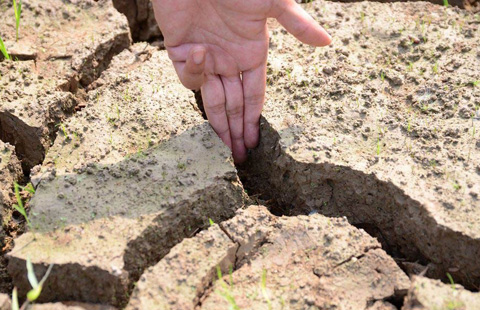Art exchange
Updated: 2015-04-28 07:24
By Deng Zhangyu(China Daily)
|
||||||||
With an approach like a stock exchange, a new platform gives ordinary art buyers a chance to discover underappreciated artists, reports Deng Zhangyu.
A new trading model for art went public on April 20 in Beijing, when 10 artists were listed on a stock - exchange-like market, a capitalized attempt to explore China's booming art market.
Called "artists gongpan", the model seeks to build up a new niche market targeting people who are interested in buying works of artists who are undervalued in the market. The word gongpan derives from jargon in the jade-trading market in China, where unearthed stones are shown for bidders who can offer a price.
In the new market, buyers can open an account on the platform and make purchases following artists, similar to what they can do on the stock market. Participants include artists, art dealers, financial institutions and art-service companies.
The capitalized art market is co-built by International Copyright Exchange and Yuansheng Cultural and Art Exchange based in Kunming, Yunnan province. The former is set up by the Copyright Protection Center of China, Beijing Equity Exchange and Beijing municipal government.
"Anyone who wants to invest in art can buy works of 'listed' artists every day. All the data of buying and selling is transparent and accessible to the public," says Luo Jiayuan, CEO of International Copyright Exchange.
"The waters of the traditional art-trading market in China are too deep to invest in. We offer a trading market where all information is open and real," adds Luo.
China's art market has long been criticized for difficulty in authentication, fake figures from auction houses and low liquidity. But the artists gongpan, says Luo, lists living artists, and all works sold through the trade platform are signed and authenticated by the artist himself.
After four years' research and preparation, the new trading model is based on four principles: no fake art, high liquidity, purchasing based on big data and appeal to the market instead of manipulation by some collectors or institutions, says Luo.
Luo estimates that each artist will see 100 to 200 trades on the new platform every year, compared to exposure twice a year by auction houses.
"We respect the traditional art market made up by auction houses, galleries and private dealers. It serves for private collectors. What we're doing is to open an easier market for ordinary people, or for a broader base of investors," he adds.
With China's art market expected to continue to expand in the next 20 years, experts are hailing the creation of a bigger art market rather than a narrow one popular only among collectors.
Huang Jun, deputy director of China Art Financial Institute, says a creative trading model should encourage more participants including ordinary art lovers to join in. It should be open and include all kinds of investors.
The rise of new trading models, such as online art dealers and small-scale auctions on the popular instant-messaging app WeChat, is changing the art market dominated by large auction houses and galleries, says Huang.
Although figures released by China's compiler of art statistics Artron.net show that sale of China's art market dropped by 18 percent last year compared with 2013, the average rate of return of Chinese artworks keeps on a double-digit, up to 19 percent.
Peng Zhongtian, founder of the new platform, says that one of its aims is to boost the value of underestimated artists in China.
For example, among the first 10 "listed" artists, traditional Chinese painter Liu Bojun, 94, learned art from art masters like Pan Tianshou (1897-1971) and Lin Fengmian (1900-91). He was a classmate of Zao Wou-ki and Chu Teh-chun. Because of his imprisonment during the "cultural revolution" (1966-76), Liu lived in seclusion in rural areas after being freed. Liu's art pieces rarely go to the market.
"We want to find artists like Liu, and list their works on the exchange market. Investors will vote with money for their favored artists. To some extent, they grow up with their invested artist," Peng says, explaining that the difficulty in finding underestimated artists makes the first listing small. But he's confident that in the future more artists will be joining.
Contact the writer at dengzhangyu@chinadaily.com.cn
(China Daily 04/28/2015 page21)

 International rescue teams head to quake-hit Nepal
International rescue teams head to quake-hit Nepal
 World's deadliest earthquakes since 1900s
World's deadliest earthquakes since 1900s
 Rescuers deliver relief supplies on foot
Rescuers deliver relief supplies on foot
 China brings trapped nationals home from quake-hit Nepal
China brings trapped nationals home from quake-hit Nepal
 Severe drought hits Southwest China
Severe drought hits Southwest China
 History razed in Nepal earthquake
History razed in Nepal earthquake
 'Chi-pao teachers' found in Guangdong
'Chi-pao teachers' found in Guangdong
 Tourists evacuated from Nepal quake area arrive in Kunming
Tourists evacuated from Nepal quake area arrive in Kunming
Most Viewed
Editor's Picks

|

|

|

|

|

|
Today's Top News
Chinese, Koreans seek Japan apology
China rescue team starts work
Three US citizens among dead in avalanche after Nepal quake
Chinese rally across US to support NYC police officer under indictment
New publication will focus on China's energy industry
Abe's US trip: sense or sensibility?
China to overtake US in mobile gaming market
Nearly 2,500 confirmed dead in Nepal quake
US Weekly

|

|







